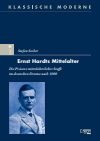Zusammenfassung
Mittelalter hat in der Gegenwartskultur Konjunktur. Aber bereits nach 1900 waren mittelalterliche Stoffe sehr beliebt – anhand des Erfolgsdramas „Tantris der Narr“ von Ernst Hardt wird in dieser Studie ein Zugang zur produktiven Mittelalterrezeption nach der Jahrhundertwende erarbeitet. Mit Bezug auf „Tantris“ und die anschließenden Mittelalterstücke wird insbesondere Hardts Umgang mit Frauenrollen und deren Psychologie im Spannungsfeld von Mittelalterbezug und Aktualisierung beleuchtet und die Frage nach dem Mediävalismus als Forschungsthema auch für die neuere Literatur gestellt. Hardts Arbeiten erweisen sich dabei als Blaupausen für andere populäre Dramatisierungen mittelalterlicher Stoffe.
Abstract
The Middle Ages are booming in contemporary culture, but medieval material was already very popular after 1900: This study uses the successful drama "Tantris der Narr" by Ernst Hardt to develop an approach to the productive reception of the Middle Ages after the turn of the century. For "Tantris" and the subsequent medieval plays, Hardt’s approach, especially with regard to the female characters and their psychology, is examined with regard to the tension between updating and medieval reference. Hardt's work proves to be a blueprint for other popular dramatizations of medieval material and has relevance for contemporary medievalism in literature and philology.
Schlagworte
1900 literary studies Ernst Hardt literature medieval reception Frauenrollen Jahrhundertwende medieval themes Literaturwissenschaft medievalism Mediävalismus Middle Ages Mittelalter Tantris the Fool mittelalterliche Stoffe turn of the century Mittelalterrezeption women's roles Tantris der Narr- 53–124 III. Tantris der Narr 53–124
- 125–158 IV. Gudrun 125–158
- 159–188 V. Schirin und Gertraude 159–188

